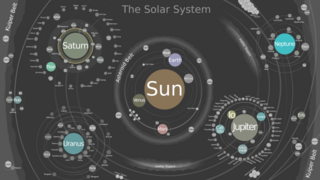Related Research Articles

The Oort cloud, sometimes called the Öpik–Oort cloud, is theorized to be a vast cloud of icy planetesimals surrounding the Sun at distances ranging from 2,000 to 200,000 AU. The concept of such a cloud was proposed in 1950 by the Dutch astronomer Jan Oort, in whose honor the idea was named. Oort proposed that the bodies in this cloud replenish and keep constant the number of long-period comets entering the inner Solar System—where they are eventually consumed and destroyed during close approaches to the Sun.

The asteroid belt is a torus-shaped region in the Solar System, centered on the Sun and roughly spanning the space between the orbits of the planets Jupiter and Mars. It contains a great many solid, irregularly shaped bodies called asteroids or minor planets. The identified objects are of many sizes, but much smaller than planets, and, on average, are about one million kilometers apart. This asteroid belt is also called the main asteroid belt or main belt to distinguish it from other asteroid populations in the Solar System.

The giant-impact hypothesis, sometimes called the Big Splash, or the Theia Impact, suggests that the Moon was formed from the ejecta of a collision between the early Earth and a Mars-sized planet, approximately 4.5 billion years ago in the Hadean eon. The colliding body is sometimes called Theia, named after the mythical Greek Titan who was the mother of Selene, the goddess of the Moon. Analysis of lunar rocks published in a 2016 report suggests that the impact might have been a direct hit, causing a fragmentation and thorough mixing of both parent bodies.
In the history of astronomy, a handful of Solar System bodies other than Jupiter have been counted as the fifth planet from the Sun.
In astronomy or planetary science, the frost line, also known as the snow line or ice line, is the minimum distance from the central protostar of a solar nebula where the temperature is low enough for volatile compounds such as water, ammonia, methane, carbon dioxide and carbon monoxide to condense into solid grains, which will allow their accretion into planetesimals. Beyond the line, otherwise gaseous compounds can be quite easily condensed to allow formation of gas and ice giants; while within it, only heavier compounds can be accreted to form the typically much smaller rocky planets.

The formation of the Solar System began about 4.6 billion years ago with the gravitational collapse of a small part of a giant molecular cloud. Most of the collapsing mass collected in the center, forming the Sun, while the rest flattened into a protoplanetary disk out of which the planets, moons, asteroids, and other small Solar System bodies formed.
The Hungaria asteroids, also known as the Hungaria group, are a dynamical group of asteroids in the asteroid belt which orbit the Sun with a semi-major axis between 1.78 and 2.00 astronomical units (AU). They are the innermost dense concentration of asteroids in the Solar System—the near-Earth asteroids are much more sparse—and derive their name from their largest member 434 Hungaria. The Hungaria group includes the Hungaria family, a collisional asteroid family which dominates its population.

The Mars trojans are a group of trojan objects that share the orbit of the planet Mars around the Sun. They can be found around the two Lagrangian points 60° ahead of and behind Mars. The origin of the Mars trojans is not well understood. One theory suggests that they were primordial objects left over from the formation of Mars that were captured in its Lagrangian points as the Solar System was forming. However, spectral studies of the Mars trojans indicate this may not be the case. Another explanation involves asteroids chaotically wandering into the Mars Lagrangian points later in the Solar System's formation. This is also questionable considering the short dynamical lifetimes of these objects. The spectra of Eureka and two other Mars trojans indicates an olivine-rich composition. Since olivine-rich objects are rare in the asteroid belt it has been suggested that some of the Mars trojans are captured debris from a large orbit-altering impact on Mars when it encountered a planetary embryo.

The history of scientific thought about the formation and evolution of the Solar System began with the Copernican Revolution. The first recorded use of the term "Solar System" dates from 1704. Since the seventeenth century, philosophers and scientists have been forming hypotheses concerning the origins of our Solar System and the Moon and attempting to predict how the Solar System would change in the future. René Descartes was the first to hypothesize on the beginning of the Solar System; however, more scientists joined the discussion in the eighteenth century, forming the groundwork for later hypotheses on the topic. Later, particularly in the twentieth century, a variety of hypotheses began to build up, including the now-commonly accepted nebular hypothesis.

The Nicemodel is a scenario for the dynamical evolution of the Solar System. It is named for the location of the Côte d'Azur Observatory—where it was initially developed in 2005—in Nice, France. It proposes the migration of the giant planets from an initial compact configuration into their present positions, long after the dissipation of the initial protoplanetary disk. In this way, it differs from earlier models of the Solar System's formation. This planetary migration is used in dynamical simulations of the Solar System to explain historical events including the Late Heavy Bombardment of the inner Solar System, the formation of the Oort cloud, and the existence of populations of small Solar System bodies such as the Kuiper belt, the Neptune and Jupiter trojans, and the numerous resonant trans-Neptunian objects dominated by Neptune.

The Late Heavy Bombardment (LHB), or lunar cataclysm, is a hypothesized event thought to have occurred approximately 4.1 to 3.8 billion years (Ga) ago, at a time corresponding to the Neohadean and Eoarchean eras on Earth. According to the hypothesis, during this interval, a disproportionately large number of asteroids and comets collided with the early terrestrial planets in the inner Solar System, including Mercury, Venus, Earth and Mars. These came from both post-accretion and planetary instability-driven populations of impactors. Although it used to be widely accepted, it remained difficult to provide an overwhelming amount of evidence for the hypothesis. However, recent re-appraisal of the cosmo-chemical constraints indicates that there was likely no late spike in the bombardment rate.
The five-planet Nice model is a numerical model of the early Solar System that is a revised variation of the Nice model. It begins with five giant planets, the four that exist today plus an additional ice giant between Saturn and Uranus in a chain of mean-motion resonances.

The following outline is provided as an overview of and topical guide to the Solar System:

The E-belt asteroids were the population of a hypothetical extension of the primordial asteroid belt proposed as the source of most of the basin-forming lunar impacts during the Late Heavy Bombardment.
The jumping-Jupiter scenario specifies an evolution of giant-planet migration described by the Nice model, in which an ice giant is scattered inward by Saturn and outward by Jupiter, causing their semi-major axes to jump, quickly separating their orbits. The jumping-Jupiter scenario was proposed by Ramon Brasser, Alessandro Morbidelli, Rodney Gomes, Kleomenis Tsiganis, and Harold Levison after their studies revealed that the smooth divergent migration of Jupiter and Saturn resulted in an inner Solar System significantly different from the current Solar System. During this migration secular resonances swept through the inner Solar System exciting the orbits of the terrestrial planets and the asteroids, leaving the planets' orbits too eccentric, and the asteroid belt with too many high-inclination objects. The jumps in the semi-major axes of Jupiter and Saturn described in the jumping-Jupiter scenario can allow these resonances to quickly cross the inner Solar System without altering orbits excessively, although the terrestrial planets remain sensitive to its passage.

Theia is a hypothesized ancient planet in the early Solar System that, according to the giant-impact hypothesis, collided with the early Earth around 4.5 billion years ago, with some of the resulting ejected debris gathering to form the Moon. Such a collision, with the two planets' cores and mantles fusing, could explain why Earth's core is larger than expected for a body its size. Theia is hypothesized to have been about the size of Mars, and may have formed in the outer Solar System and provided much of Earth's water.

In planetary astronomy, the grand tack hypothesis proposes that Jupiter formed at a distance of 3.5 AU from the Sun, then migrated inward to 1.5 AU, before reversing course due to capturing Saturn in an orbital resonance, eventually halting near its current orbit at 5.2 AU. The reversal of Jupiter's planetary migration is likened to the path of a sailboat changing directions (tacking) as it travels against the wind.
Comparative planetary science or comparative planetology is a branch of space science and planetary science in which different natural processes and systems are studied by their effects and phenomena on and between multiple bodies. The planetary processes in question include geology, hydrology, atmospheric physics, and interactions such as impact cratering, space weathering, and magnetospheric physics in the solar wind, and possibly biology, via astrobiology.

Pebble accretion is the accumulation of particles, ranging from centimeters up to meters in diameter, into planetesimals in a protoplanetary disk that is enhanced by aerodynamic drag from the gas present in the disk. This drag reduces the relative velocity of pebbles as they pass by larger bodies, preventing some from escaping the body's gravity. These pebbles are then accreted by the body after spiraling or settling toward its surface. This process increases the cross section over which the large bodies can accrete material, accelerating their growth. The rapid growth of the planetesimals via pebble accretion allows for the formation of giant planet cores in the outer Solar System before the dispersal of the gas disk. A reduction in the size of pebbles as they lose water ice after crossing the ice line and a declining density of gas with distance from the sun slow the rates of pebble accretion in the inner Solar System resulting in smaller terrestrial planets, a small mass of Mars and a low mass asteroid belt.
References
- ↑ Space.com: "Long-Destroyed Fifth Planet May Have Caused Lunar Cataclysm, Researchers Say"
- 1 2 Chambers, J. E.; Lissauer, J. J. (2002). "A New Dynamical Model for the Lunar Late Heavy Bombardment" (PDF). Lunar and Planetary Institute Science Conference Abstracts. 33: 1093. Bibcode:2002LPI....33.1093C.
- ↑ Chambers, J. E. (2007). "On the stability of a planet between Mars and the asteroid belt: Implications for the Planet V hypothesis". Icarus. 189 (2): 386–400. Bibcode:2007Icar..189..386C. doi:10.1016/j.icarus.2007.01.016.
- 1 2 Brasser, R; Morbidelli, A. (2011). "The terrestrial Planet V hypothesis as the mechanism for the origin of the late heavy bombardment". Astronomy & Astrophysics. 535: A41. Bibcode:2011A&A...535A..41B. doi:10.1051/0004-6361/201117336.
- ↑ Minton, D. A.; Jackson, A. P.; Asphaug, E.; Fassett, C. I.; Richardson, J. E. (2015). "Debris from Borealis Basin Formation as the Primary Impactor Population of Late Heavy Bombardment" (PDF). Workshop on Early Solar System Impact Bombardment III. 1826: 3033. Bibcode:2015LPICo1826.3033M.
- ↑ Minton, David A.; Richard, James E.; Fassett, Caleb I. (2015). "Re-examining the main asteroid belt as the primary source of ancient lunar craters". Icarus. 247: 172–190. arXiv: 1408.5304 . Bibcode:2015Icar..247..172M. doi:10.1016/j.icarus.2014.10.018. S2CID 55230320.
